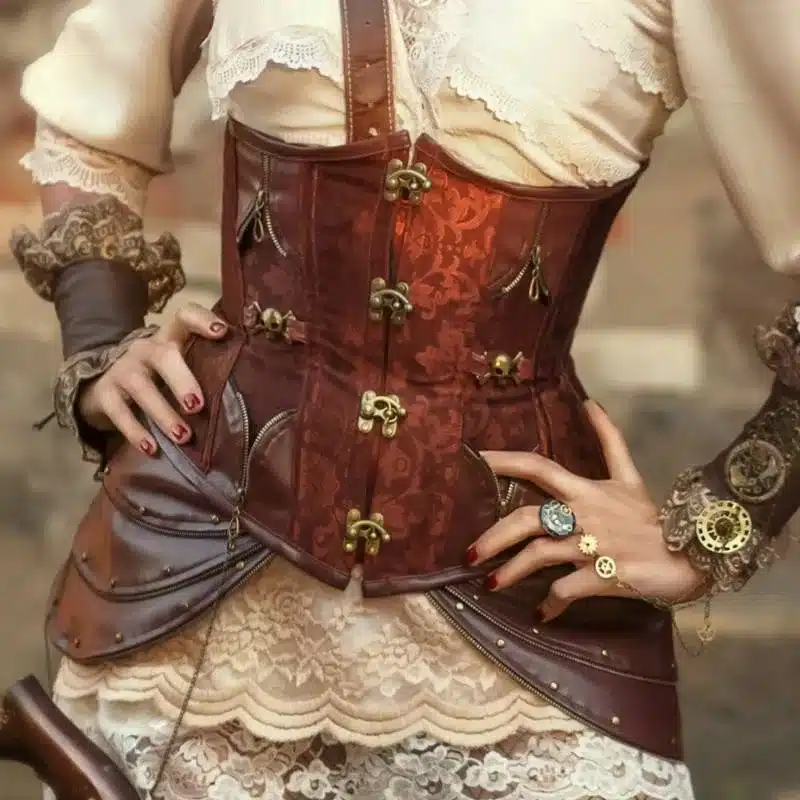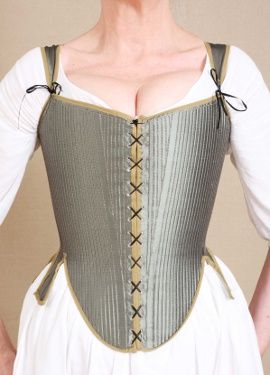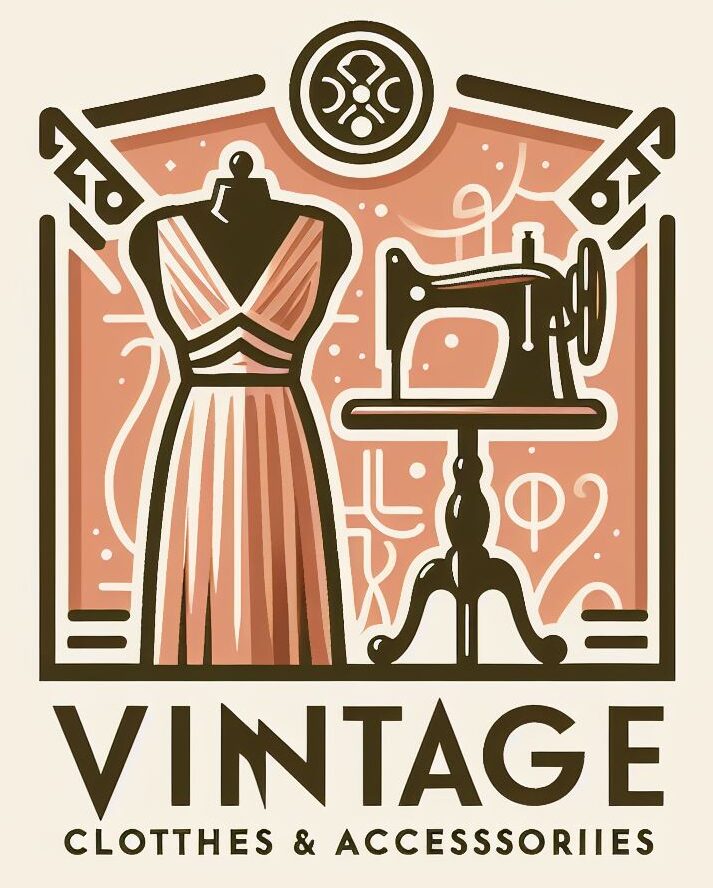Embracing the Elegance of the Past: Why Victorian-Inspired Fashion Captivates Modern Women
Intro to Victorian inspired fashion and its timeless allure

Victorian-inspired fashion draws heavily from the styles and aesthetics popular during the reign of Queen Victoria (1837-1901). This period is known for its intricate designs, opulent fabrics, and a sense of formality that has continued to captivate fashion enthusiasts and designers.
Key Elements of Victorian Fashion
Silhouettes and Structures:
Corsets:

Central to the Victorian silhouette, corsets were used to cinch the waist and create an hourglass figure.They emphasized a woman’s waist while enhancing the bust and hips at the same time.
18th Century corsets of all styles and colours are available through Etsy today. Cheaper versions can be found online at Amazon.
Bustles and Crinolines:

These were used to shape skirts, creating volume and structure. Bustles added fullness to the back of skirts, while crinolines created a bell-shaped silhouette.
High Necklines and Long Sleeves:

Modesty was a key aspect of Victorian fashion, with high necklines and long sleeves being predominant, especially in day-wear for all women.
Amazon have a selection of Victorian style dress, see if you can find something here. And, if you scroll through this site, there are dresses with high necklines and long sleeves here. Alternatively, tops with high necklines and long sleeves are bought here online.
Fabrics and Textures:
Lush Fabrics:

Velvet, silk, and lace were widely used, and often adorned with intricate embroidery and beadwork.
An assortment of vintage silk fabrics are bought through Etsy online.
Patterns and Colors:

Floral prints, plaids, and rich, deep colors like – burgundy, emerald, and navy were popular. Black also became a significant color, particularly after Prince Albert’s death, when Queen Victoria wore mourning black for the rest of her natural life.
Many floral print fabrics in vintage colours are right here at Etsy today.
Accessories:
Hats and Bonnets:

These were an essential part of the ensemble – for both protection and for fashion – often decorated with feathers, flowers, and ribbons.
Choose a hat or bonnet that’s right for you with this great selection here. More affordable reproduced styles are sourced through Amazon
Gloves and Parasols:

Gloves were worn at all times by ladies, and parasols were used to protect their pale skin from the sun – while adding a touch of elegance.
Traditional gloves and parasols are sourced through Etsy today. While reproduced Victorian gloves can be bought at Amazon
Jewelry:

Cameos, lockets, and brooches were fashionable, often made from gold, ivory, pearls, and precious stones.
Some authentic cameos and lockets are found online at Etsy. Reproductions can be bought through Amazon today.
Timeless Allure
Romance and Feminine Aesthetics:
The Victorian era focused on intricate details and romantic silhouettes, which continues to inspire contemporary fashion. The femininity and grace associated with Victorian fashion offer an enduring appeal.
Historical and Cultural Significance:
Victorian fashion represents a fascinating period of history marked by social and technological changes. The era’s fashion reflects its cultural context, making it a rich source of inspiration for designers and fashion historians.
Revival in Modern Fashion:
Elements of Victorian fashion frequently resurface in modern dress trends. High-neck blouses, lace detailing, and corset-inspired pieces are often seen on runways and in everyday fashion.
Gothic and steampunk subcultures have also embraced Victorian elements, blending them with industrialism with a modern twist – to create unique and striking looks.

As an affiliate, I may receive a commission when you click on a link and purchase an item
Adaptability:
While traditional Victorian fashion may seem elaborate, its elements can be adapted to modern tastes. Simplified versions of Victorian dresses, corset tops, and lace accessories can easily be incorporated into contemporary wardrobes.
Notable Examples in Modern Fashion
High End Fashion: Designers like Alexander McQueen, Vivienne Westwood, and Dolce & Gabbana have all drawn inspiration from Victorian fashion, incorporating its elements into their collections.
Popular Culture: Films and TV series set in the Victorian era, such as “North and South” and “Jane Eyre,” often showcase Victorian-inspired fashion, contributing to its ongoing popularity.


Victorian-inspired fashion continues to enchant and inspire with its rich history, romantic aesthetics, and ability to adapt to modern trends. Its timeless allure lies in the delicate balance between historical and contemporary relevance.
The romance of Victorian aesthetics: lace, corsets, voluminous skirts
Victorian aesthetics are often characterized by their elaborate and romantic styles, particularly in fashion, interior design, and art. The period during the reign of Queen Victoria, saw a distinct emphasis on intricate detail, opulence, and a blend of historical influences. We explore three key elements – lace, corsets, and voluminous skirts.
Lace
Lace was a quintessential feature of Victorian fashion. This delicate and intricate fabric was often used in clothing, accessories, as well as home decor. Why not look into the wide variety of lace is available through Etsy online.
Fashion: Lace was incorporated into dresses, blouses, and even undergarments such as drawers. It was prized for its delicate appearance and the skill required to produce it. Wealthy women adorned themselves with lace collars, cuffs, and shawls. But lace-trimmed petticoats – added an extra layer of luxury.



Bridal Wear: Lace was particularly significant in bridal fashion. Queen Victoria herself set a trend when she wore a white lace gown for her wedding to Prince Albert in 1840, popularizing the white wedding dress. If you’re looking to repurpose a Victorian wedding dress look no further than this authentic selection today.
Accessories: This delicate fabric was also used in accessories such as gloves, parasols, and handkerchiefs – adding an elegant touch to a lady’s ensemble. Classic lace hankerchiefs are purchased here.
Corsets
Corsets were a defining element of Victorian women’s fashion – shaping the body to conform to the ideal silhouette of the time. As an alternative, some corset styles or patterns can be sourced here.
Silhouette: The corset created an hourglass figure by cinching the waist and supporting the bust. This was essential for achieving the fashionable shape of the period, which emphasized a full bust, narrow waist, and wide hips.

Construction: Victorian corsets were typically made from strong fabrics like cotton or silk, reinforced with boning made of whalebone, steel, or cane. They were fastened with a busk at the front and laces at the back, allowing for a tight fit.
Health and Controversy: While corsets were the staple of fashion, they were also a subject of controversy. Critics argued that tightly laced corsets could and did cause health issues – including compromising fertility, respiratory problems and deformed rib cages. Despite all this, many women still wore them daily.
Voluminous Skirts
The Victorian silhouette was often characterized by voluminous skirts, which evolved in shape and structure throughout the era.
Crinolines and Hoop Skirts: In the mid-19th century, crinolines and hoop skirts became popular. These garments used steel hoops or horsehair to create a bell-shaped silhouette – making skirts appear full and expansive without the weight of multiple petticoats.


Bustles: By the late 19th century, the focus shifted to the back of the skirt – with the introduction of the bustle. Bustles added volume and drapery to the rear of the skirt, creating a distinctive profile that highlighted the waist and hips.
Fabrics and Decoration: Victorian skirts were usually made from rich fabrics such as silk, velvet, and taffeta – adorned with lace, ribbons, and embroidery. Patterns and layers added texture and depth, enhancing the luxurious feel.
Conclusion
The romance of Victorian aesthetics is vividly captured in the fashion of the time – with lace, corsets, and voluminous skirts playing central roles. These elements not only defined the physical appearance of Victorian women but also reflected the cultural values and social norms of the era. The attention to detail, craftsmanship, and the pursuit of an idealized beauty continue to influence modern fashion and design, preserving the legacy of Victorian romance.
Customization and individuality: how to incorporate Victorian elements into everyday wear
Incorporating Victorian elements into everyday wear can add a touch of elegance and uniqueness to your style. Here are some tips on how to blend Victorian fashion with modern clothing to create Victorian inspired fashion.
Clothing
Blouses and Tops:
High Collars: Choose pastel coloured blouses with high collars, ruffles, or lace trim.
Puffed Sleeves: Opt for tops with puffed or bell sleeves to create a Victorian silhouette.
Skirts and Dresses:
A-Line and Maxi Skirts: Wear skirts that have a rather modest, flowing cut. Regency inspired dresses are found through this site online.
Tea Dresses: Look for dresses that have a peasant feel – with floral patterns, lace details, and fitted bodices.
Outerwear:
Tailored Jackets and Coats: Choose pieces with structured shoulders and nipped-in waists. Look for velvet, brocade or satin fabrics.
Capes and Shawls: These can be worn over modern outfits to add a hint of Victorian flair.



Accessories
Hats and Headwear:
Bonnet-Style Hats: Modern interpretations of Victorian bonnets can be found in contemporary millinery, or create your own – simple instructions are given in bonnet/hat patterns designs.
Fascinators: Small, decorative headpieces can add an old world touch to your look.
Jewelry:
Cameo Brooches: These can be worn on blouses, jackets, or even as hair accessories.
Lockets and Pendants: Victorian-style lockets or ornate pendants on long chains can enhance any outfit.
Long or Lace Gloves: Short or long gloves were worn as a status symbol, including fingerless gloves and opera gloves. These can be an elegant addition to formal or semi-formal attire.
Footwear:
Boots: Victorian-style ankle boots with lace-up fronts or buttons can be paired with modern outfits.
Cuban Heel lace shoes: These shoes are comfortable and practical, while giving a nod to Victorian fashion, for everyday wear.

Fabrics and Patterns
Lace and Velvet: Incorporate these type of fabrics into your wardrobe, for a touch of Victorian luxury.
Floral and Brocade Patterns: These patterns can be found in modern clothing – generally as a 2 piece suit or a dress, giving a vintage twist.
Hairstyles and Makeup
Hairstyles: Consider a hairstyle with soft curls, braids, or an updo. Hair accessories like ribbons, combs, or vintage decorative pins can add a Victorian touch.
Makeup: Keep makeup natural, with a focus on rosy cheeks and soft mascara. A bold red or deep berry lipstick, can complete the look.
Modern Integration
Mix and Match: Combine Victorian-inspired pieces with contemporary items. For example, pair a ruffled blouse with jeans, or a lace skirt with a modern top.
Layering: Use Victorian-style outerwear or accessories to layer over your regular clothes. A long modern A-line dress can look completely different with a Victorian cape or shawl.


Customization
DIY Alterations: Add Victorian elements to your existing wardrobe. Sew lace trim onto blouses, add vintage buttons to jackets, or embellish skirts with ribbon, if you craft inclined.
Vintage Finds: Look for authentic Victorian pieces or good reproductions at thrift stores, vintage shops, or online. Even a single vintage accessory, as a statement piece – can transform an outfit.
Incorporating Victorian elements into your everyday wear allows for creativity and self-expression, blending history with modern style for a unique and personalized look.
Why women are drawn to Victorian glamour: a combination of aesthetics, femininity, and a sense of history
Women can drawn to the glamour of Victorian fashion for several reasons. Blending aesthetics, femininity, and a sense of history is indeed appealing to many.
Aesthetics
Elegance and Detail: Victorian fashion is renowned for its intricate detailing, with the use of lace, embroidery, and elaborate patterns. Either of these elements create a sense of luxury and sophistication.
Silhouettes: The distinct silhouettes which includes corseted waists, voluminous skirts, and high necklines – emphasize a dramatic and romantic style, that many find visually captivating.
Timeless Beauty: The classic and timeless nature of Victorian fashion allows it to remain relevant and admired in contemporary times.
Femininity
Grace and Poise: Victorian fashion often accentuates grace and poise – where structured garments enhance the female form – request a certain posture from the wearer, while maintaining a sense of modesty.
Romanticism: The era’s emphasis on romantic and delicate designs appeals to those who imagine and appreciate a softer, more feminine aesthetic.
Attention to Detail: The meticulous attention to detail in Victorian fashion reflects a certain kind of awareness and craftsmanship that can be seen as an expression of self-respect and personal pride.
Sense of History
Nostalgia: The Victorian era is often romanticized in literature, film, and culture – evoking a sense of nostalgia and longing for a bygone era of refinement and elegance.
Cultural Heritage: For many, Victorian fashion represents a connection to their own cultural heritage and family history, making it personally meaningful.
Historical Significance: Wearing and appreciating Victorian fashion allows individuals to engage with history – experiencing a tangible link to the past and understanding the social and cultural dynamics of the era.

Combining These Elements
The combination of aesthetics, femininity, and history creates a multifaceted allure. Victorian glamour offers a way to celebrate beauty, express personal style, and connect with a rich cultural legacy. This blend appeals to women who value elegance, tradition, and the romantic charm of the past.
Why did designers bring back Victorian inspired fashion in the 1980’s
Designers during the 1980’s revived Victorian-inspired fashion for several reasons, blending historical influence with contemporary styles to create unique and innovative looks.
Nostalgia and Romanticism: The 1980’s saw a resurgence of interest in past eras, including the Victorian period. This nostalgia brought romantic elements like lace, high collars, and elaborate detailing back into fashion, offering a contrast to the decade’s more futuristic and minimalist trends.
Theatrical and Dramatic Appeal: Victorian fashion is characterized by its opulence and drama, which fitted well with the 1980s’ emphasis on bold, statement-making styles. The dramatic silhouettes, rich fabrics, and intricate embellishments of Victorian fashion provided designers with a wealth of inspiration for creating eye-catching garments.
Rebellion Against Minimalism: The late 1970’s and early 1980’s were marked by minimalist and utilitarian trends. Victorian-inspired fashion offered a contradiction to this simplicity – allowing designers to explore more extravagant and ornate designs.
Cultural and Media Influence: Popular culture, including films, television shows, and music videos, played a significant role in shaping fashion trends. Period dramas and music videos with historical themes often showcased Victorian-inspired costumes, influencing mainstream fashion.
Subcultural Influences: The punk and gothic subcultures of the 1980’s drew heavily from Victorian aesthetics. These subcultures embraced dark, romantic styles that included Victorian elements like corsets, lace, and ruffles, which in turn, influenced high fashion.
Postmodernism in Fashion: The 1980’s were a time of postmodernism, where mixing different styles and eras became popular. Designers felt free to blend Victorian elements with modern aesthetics, creating eclectic and innovative designs.
These contributing factors combined to make Victorian-inspired fashion a distinctive and memorable part of the 1980’s fashion landscape.

Hope you enjoyed this post on the fabulous ways you can incorporate Victorian glamour into every day wear.
Cheers, Helen.
You can connect with us via our socials, or alternatively leave me a message below.

Remarkable! Its genuinely awesome paragraph, I have got muh clear
idea about from this piece of writing. https://lvivforum.Pp.ua
Appreciate that Kathaleen.